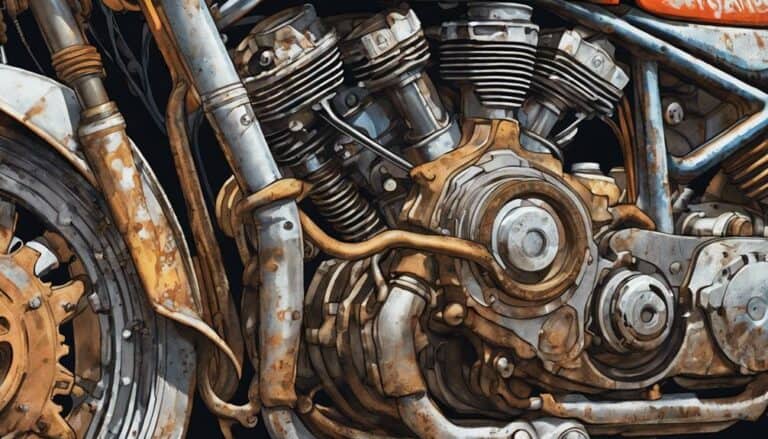If you're wondering whether it's time to replace your dirt bike's crankcase bearings, you might be thinking that it's a complex and costly procedure. However, knowing the telltale signs of failing bearings can save you from more significant issues down the line.
But what exactly are these signs, and how can you identify them before it's too late? Let's explore the subtle hints that your crankcase bearings might be giving you and why timely action is essential for your bike's longevity and performance.
Key Takeaways
- Regular inspections every 50-100 hours are crucial.
- Address abnormal engine noises promptly.
- Timely replacement prevents catastrophic engine failure.
- Proper lubrication and maintenance extend bearing lifespan.
Signs of Worn Crankcase Bearings
Experiencing excessive play in the movement of your crankshaft indicates worn crankcase bearings. When the crank bearings near the rod end of the bottom end wear out, they allow for unwanted movement in the crankshaft. The cases split to reveal the internals, showing visible wear, scarring, or damage on the crank bearings, a clear indication that replacement is necessary. The thermal expansion of the components can exacerbate this issue, leading to increased play and potential engine damage.
If abnormal engine noises like knocking or grinding arise, it's a clear sign that the crank bearings are in need of replacement. Any new vibrations or changes in engine performance shouldn't be ignored, as they could be symptoms of deteriorating crankcase bearings. This type of wear can manifest in reduced engine power, loss of performance, or even difficulty starting the engine. Inspecting and replacing the crank bearings in a timely manner is essential for maintaining the health and performance of your dirt bike.
Importance of Timely Replacement
Regularly replacing dirt bike crankcase bearings is important to prevent catastrophic engine failure and maintain peak performance. Failure to address worn bearings promptly can lead to a domino effect of issues that affect the overall efficiency of your engine. Here's why timely replacement is vital:
- Preventing Catastrophic Failure: Ignoring worn crankcase bearings can result in catastrophic engine failure, potentially causing extensive damage beyond just the bearings themselves.
- Maintaining Engine Performance: Worn bearings can lead to reduced engine performance and power output, impacting your overall riding experience.
- Ensuring Optimum Efficiency: Regular inspection and replacement of crankcase bearings ensure peak engine efficiency, keeping your dirt bike running smoothly.
- Prolonging Engine Lifespan: Replacing crankcase bearings during scheduled maintenance not only prevents immediate issues but also helps prolong the lifespan of your engine, saving you money in the long run.
Common Causes of Bearing Failure
To understand the root causes of dirt bike crankcase bearing failure, it's imperative to recognize the detrimental effects of factors such as lack of proper lubrication and contamination. Dirt bike crank bearings play a critical role in the engine's operation, and when they aren't adequately lubricated, the metal-on-metal contact can lead to premature wear and eventual failure. Contamination, whether from dirt, debris, or water, can also infiltrate the bearings, causing abrasion and reducing their lifespan.
Excessive heat generated during prolonged high RPM operation poses another common threat to crankcase bearings in dirt bikes. The increased temperature can expedite the degradation of the bearings, leading to potential issues with the crank assembly. Additionally, overloading the engine or subjecting it to excessive stress can strain the bearings beyond their capacity, resulting in accelerated wear and failure.
Regular maintenance and inspections are vital to detecting any early signs of wear or damage in the bearings, emphasizing the importance of replacing them periodically to ensure peak performance and longevity of the dirt bike engine.
DIY Vs. Professional Replacement
For those considering replacing dirt bike crankcase bearings, the decision between DIY and professional replacement is important for ensuring the best engine performance. When it comes to your bike's engine, here are some key points to consider:
- Professional Expertise: Professional mechanics have the expertise and experience to handle the delicate process of bearing replacement with precision.
- Proper Tools: Professionals possess specialized tools required to split the cases and replace the crankcase bearings accurately.
- Risk of DIY: DIY replacement may lead to improper installation, potentially damaging the engine if not done correctly.
- Costly Mistakes: Opting for professional replacement can prevent costly mistakes and ensure that your engine operates at its optimal performance level.
Consider your level of familiarity with engine mechanics and the complexity of splitting the cases before deciding whether to tackle the replacement yourself or enlist the help of a professional.
Recommended Maintenance Schedule
Inspect and replace crankcase bearings every 50-100 hours of riding to maintain peak engine performance and prevent potential damage. Regular maintenance of crankcase bearings is essential for guaranteeing engine health. Signs of wear like abnormal noises or reduced engine performance indicate the need for prompt bearing replacement. Following manufacturer guidelines for inspection intervals guarantees the longevity of your engine. Proper lubrication and consistent monitoring of bearing conditions are key to extending the lifespan of your crankcase bearings.
| Maintenance Task | Frequency |
|---|---|
| Crankcase bearing check | Every 50-100 hours |
| Bearing replacement | As needed based on wear |
| Lubrication check | Every 10-20 hours |
| Engine performance test | Every 25-50 hours |
| Manufacturer guidelines | Follow for optimum results |
Conclusion
To sum up, proper maintenance of dirt bike crankcase bearings is critical for peak performance. Avoiding delay in replacement can prevent catastrophic engine damage.
Remember, regular inspection and using high-quality bearings from reputable manufacturers like KOYO, SKF, FAG, or Timken is key to extending the engine's lifespan.
Don't delay, detect deterioration, and diligently replace bearings to guarantee engine efficiency and longevity.

